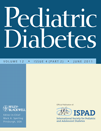HLA-DQ haplotypes differ by ethnicity in patients with childhood-onset diabetes
Abstract
Lipton RB, Drum M, Greeley SAW, Danielson KK, Bell GI, Hagopian WA. HLA-DQ haplotypes differ by ethnicity in patients with childhood-onset diabetes.
Aim: To understand the etiology of childhood-onset diabetes, we examined genetic risk markers, autoantibodies, and β-cell function in a mixed race group of young patients.
Methods: One hundred and forty-five patients aged 0–17 at diagnosis (54% African American, 22% Caucasian, 16% Latino, 8% mixed-other) were studied at mean duration 6.9 ± 5.7 (range 0.1–28.5) yr, including human leukocyte antigen (HLA)-DQA1-DQB1 genotyping, stimulated C peptide (CP), glutamic acid decarboxylase, and insulinoma-associated antigen 2 antibodies (ABs). Based on no residual β-cell function (CP-) and islet autoantibodies (AB+), 111 patients were classified with type 1 diabetes mellitus (T1DM), 22 were CP+ and AB- and thus considered to have type 2 diabetes mellitus (T2DM), and 12 patients had features of both T1DM and T2DM or mixed phenotype.
Results: Based on the presence of two high-risk HLA-DQA1/B1 haplotypes, 39% of African Americans, 81% of Caucasians, 70% of Latinos, and 67% of mixed-others were at high genetic risk. In patients with T1DM, 41% of African Americans, 80% of Caucasians, 73% of Latinos, and 63% of mixed-others were genetically susceptible. Thirty-one percent of African Americans, including 29% of those with T1DM, could not be characterized because their haplotypes had unknown T1DM associations. These unusual haplotypes comprised 11% in T1DM, 14% in T2DM, and 8% in patients with mixed phenotype.
Conclusions: Fifty-nine percent of childhood-onset patients with T1DM were identified with high genetic risk based on known HLA-DQA1/B1 associations. Many non-Caucasian patients carry HLA-DQ alleles whose association with T1DM is undetermined. Genetic approaches can provide insights into the etiology and appropriate treatment of childhood-onset diabetes but only if sufficient data are available in diverse ethnic groups.




